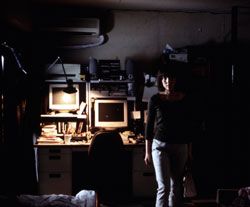Dementia Of The Damned #2

Welcome back horror hounds to the Dementia of the Damned, Cinema Blend’s monthly look at the horror genre. This month, DOTD examines the Japanese Horror genre (J-Horror, for short). American remakes are the No. 1 cause of dismissing the original films, so I traveled into the empty nothingness of the desperate and vengeful Y?rei (J-Ghosts) and found a few gems of modern-day horror. So, quit holding that grudge and get into the Japanese originals that inspired your favorite dark-haired, white-gowned ghoul.
Ghouls and Ghosts
There’s nothing like a good ghost story to chill the blood. Shadows that scatter into darkness, materializing mists and unexplained phenomena all cause an eerie quiet before a burst of laughter among friends around a camp fire. Never mind the high-tech, ghost-busting gizmos – EMF meters, infrared thermal scanners and tape-recorded EVP – there seems to be an ethereal truth that both intrigues and terrifies. If we can feel the presence of another person in the room, it’s not a stretch to think that the very same energy a person emits in his or her lifetime would still be present after death. After all, that energy has to go somewhere.
Yet, it’s the noises in the night, the whisper in an ear and the hair on the back of a neck that keep our pulses racing. This paranormal perception transcends all cultures and languages; arguably, none are better at brining that ghostly horror to the screen better than the Japanese. Much like our own ghost lore, the Japanese believe that Y?rei, traditional Japanese ghosts, are tortured spirits that roam the Earth until they can be put to rest. Although the image of long black hair wrapped in a white gown is now a J-Horror cliché (around the world), this Japanese belief is definitely not new to their culture, nor is it new to their cinema.

Before the ghastly images were packaged and sold to western cultures, through the likes of The Ring and The Grudge, Y?rei made appearances is classic Japanese cinematic treasures such as Kwaidan (1964), Ugetsu (1953) and Onibaba (1964). Half the time, as is the case with Ugetsu, these spirits were not the horrific entities we see in our theaters; they were lost souls in search of peace. In Kwaidan, however, the vengeful spirits manifest and demand restitution for their misfortunes. Unfortunately, these visually memorizing films don’t translate well. Steeped in Japanese lore and culture, they fail to resonate with the same fear that may appear in its own culture.
While those three films could never be adapted into western-friendly money makers, the latest swarm of J-Horror films seem tailor made for western audiences – at least the sub-par ones do. Oddly enough, those are the films -- Ringu (1998), Ju-on (2004) and Dark Water (2002) -- that made the best transition to and the most money in American theaters. Within the mediocrity of the genre, there are stand out films that challenge their audience both intellectually and how long you can sit watching in your dark living room before you flip on a light.
Right, Where Once Went Wrong
CINEMABLEND NEWSLETTER
Your Daily Blend of Entertainment News
There are certain places we feel protected and there are other places that we fear. Sitting in our own homes, we still fear the cracked closet door or what might lurk under the bed, but we always feel safe in bed with the covers pulled over our head. The Y?rei infect those simple fears and threaten our bed sheet safe haven. While Hideo Nakata (Ringu, Dark Water) and Takashi Shimizu (Ju-on) turn the Y?rei into nothing more than a horror movie cliché, Kiyoshi Kurosawa takes liberties with the Y?rei tradition in Kairo (Pulse, 2001).

As with most J-Horror, the summary of the plot details seems to add up to nothing more than a gimmicky thriller. For unexplained reasons, people begin committing suicide. These deaths are linked to computer phenomena, as two teens investigate what is happening to their friends. Sure, the plot sounds like a Sci-Fi Channel original, but Kurosawa crafts a philosophical horror film, not a C.G. effects ridden snoozer (ala the American Pulse). Like watching an Andrei Tarkovsky film through the guise of Eastern pop-culture, the power in Kairo lies in the questions it asks, as oppose to the limited answers it offers.
The film’s ghosts are all too real. After the finite space where souls reside after death becomes too full, these lonely souls find a way to manifest themselves through computers. When a person’s computer is utilized by the spirits, odds are that’s the next suicide victim. Yet, the reason for these suicides is largely unclear. In an utterly terrifying and depressive move, it seems that it’s the spirits’ message of loneliness after death that motivates the suicides, rather than the spirits themselves.
Psychological thrills are all well and good, but Kurosawa also succeeds at putting some of the most unnerving visuals on the screen. Perhaps his greatest visual strength is his ability to materialize his Y?rei out of thin air. Just like when Michael Myers appears into frame to take a stab at Lorie Strode in Halloween, the Y?rei are noticed just before pounce. Half way through a shot, a wave of terror washes over you as you finally see the ghostly image in the corner of the frame. Just when you’re settled, a second wave hits, as you realize that ghostly image had been there the entire time.
That trait does not go unnoticed by Takashi Miike, who helms the ironically superb One Missed Call. Again, surface appearance is deceiving as everything, down to the title, points to another run-of-the-mill J-Horror. A group of friends receive phone calls from their own cell phones, which results in a voice mail that predicts the time and circumstances of their deaths. Taking a break from more extreme and experimental films, the likes of Visitor Q and Ichi the Killer, Miike attacks every cliché the J-Horror genre has to offer and makes them work better than any other director.

From childhood trauma and abuse to the influence of technology in Japanese culture, no cliché is left unturned. Rather than turning these generalities into a parody, Miike effectively puts them to work. He starts with the rumor, hints at the misfortune promised by a haunting ring tone and then follows through with the mayhem, borrowing from Kurosawa’s materializing magic and his own story-telling sensibility. While taking thematic jabs at cell phone culture, reality T.V. and the J-Horror genre, Miike never trivializes his work. He plays it straight and delivers on the scares, even though we know they are coming.
Although Kairo has already seen a lame remake, which would be enough for American audiences to dismiss the original, One Missed Call has the fortunate fate of not being remade… yet. There is a remake in the works for 2008 and you can expect that it won’t be half as smart or well-executed as Miike’s original. However, that’s not a stead-fast rule in the world of remakes. In the cases of Ringu and Ju-on, the remakes were fairly faithful to and, in some regards, better than the originals. Both Ringu and Ju-on were the frontrunners of the shoot-by-numbers J-Horror method, and their mainstream appeal translated perfectly into Western box office gold.
With a smart film such as Kairo, it’s no wonder that the American remake was reduced to a series of jump scares. Kairo dealt with themes of death and an after life without the presence of God or Christianity. It’s refreshing to have a film actively investigate philosophical questions, without the influence of Christianity. The characters are faced with real questions that many people are too afraid to ask and then are answered by lonely spirits of the dead, who happen to confirm their worst fears. When One Missed Call has it’s time in the remake spotlight, it’s almost certain only the clichés will translate and the satirical subtext and scares will remain with the original.
Beyond the Y?rei
Even more exciting and terrifying than the Y?rei of J-Horror is the amount of excellent horror the Japanese have to offer outside the ghastly realm. Chances are Higuchinsky’s Uzumaki is safe from the remake-obsessed Hollywood. Based off a Japanese comic book, Uzumaki (Spiral) crosses J-Horror with the French New Wave. The anti-thesis of Kurosawa, Higuchinsky keeps Uzumaki rolling through quick cuts and cartoon-is horror that is still a bit shocking. Like most traditional J-Horror, a town is in trouble as its citizens become obsessed with the shape of a spiral. As if in a hypnotic trance, the town’s folk slowly become unhinged, resulting in suicide, murder and the appearance of human snails.

While the film moves at a lightning-quick pace, it’s nice to see the influence of classic cinema. Several times during dialogue, Hguchinsky shoots the character speaking in a head-on one shot, as oppose to the more standard over the shoulder shot; a technique was popularized by Yasujiro Ozu from the 1930s to the 1950s. In a time when films are manufactured at such a fast pace, it’s nice to know that some filmmakers still value the past works of other masters of cinema and strive to improve upon the state of film.
From here, the genre takes a circular ride down a spiraling slide of extremism. If you keep digging, you’ll hit the Asian hardcore soon enough. Although his audacious Audition and One Missed Call are sure fire horror crowd pleasures, Miike’s more extreme and experimental work, specifically Visitor Q, is far to off-putting to be effective. By the time you dig far enough to watch Visitor Q’s opening scene of a father have sex with his prostitute daughter, it’s probably time to come up for air.
Yet, pushing the boundaries has always been a driving force in Japanese cinema. From Akira Kurosawa pointing a camera at the sun and popularizing wipe transitions to the frame within a frame and patient family life commentary of Ozu, the progress of cinema cannot go forward without breaking a couple rules and mocking others. While it’s just a matter of time before the next J-Horror remake, time is also the only factor before another director finds a new way to capture fear and put it on screen.
This Month’s Horror Picks:
In Theaters
Vacancy (Nimród Antal, 2007)
On DVD
Kwaidan (Masaki Kobayashi, 1964)
Kairo (Kiyoshi Kurosawa, 2001)
One Missed Call (Takashi Miike, 2003)
Uzumaki (Higuchinsky, 2000)
Next Month’s Dementia of the Damned: The Masters of Horror
Most Popular





